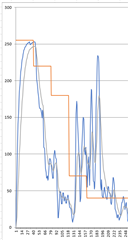Hi,
we've been reported by our customers that some of our unit's distance measurements are off.
investigation of the fifo data, shows that the echo amplitude is much higher and saturation time is much longer when temperature is lower. if you look at a cycle of 24 hours - this happens mostly during the night.
xlsx examples are attached.
you can clearly see longer saturation that crosses our defined thresholds in comparison to the 15:00 example where saturation time cuts in half,
notice that we do some filtering of the first 80 samples so that is why the begging of the fifo is distorted from the original fifo (outcome is still the same).
am I suppose to use less pulses during the night? in clod temperatures?
can you explain what causes this effect?BinId - 2375 _(4)_LogFile_26.02.22_15.xlsxBinId - 2375 _(1)_LogFile_27.02.22_22.xlsxBinId - 2375 _(2)_LogFile_27.02.22_15.xlsxBinId - 2375 _(3)_LogFile_26.02.22_22.xlsx
thanks,
guy



